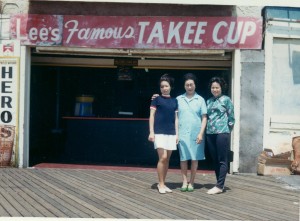September 30th, 2011 § § permalink
As HG and BSK prepare to leave their oceanfront Prince Edward Island home they gaze upon the limitless sea, the silent rocky beach, the blazing sunset. Serenity. Quiet. Isolation. Beauty. A dramatic contrast to the shores of New York’s Rockaway where HG spent his youthful summers. Rockaway was, and remains, a crowded barrier beach filled with a million (literally) sweaty New Yorkers seeking relief from the sweltering city. Every inch of the beach was filled with hairy (for the most part) men, robust (and busty) women, screaming children and hyperactive teenagers involved in the timeless mating dance. Every inch of the sandy beach was occupied. Armenian families roasted lamb in pits dug into the beach; Italians set up folding tables to hold mounds of sausage, peppers and onions; the Irish settled in with ham and cheese sandwiches plus growlers (tin pails) of tap beer from
boardwalk bars.
Little HG tasted everything. Life on the beach was noisy, friendly, communal. In this sweaty environment there were few anatomical secrets. And, of course, there was the Atlantic Ocean. HG was an active swimmer, body surfer and splasher of nubile young women.Saddest day of the year was Labor Day. Fun was over and the first day of school loomed ahead.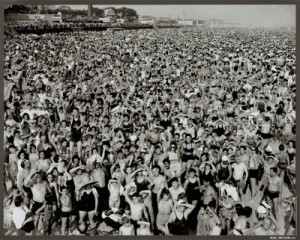
September 14th, 2011 § § permalink
In the early sixties HG was a regular attendant at a fitness club on E. 45th Street in New York. Racquetball, weight lifting, saunas and steam baths. Manly stuff. Every Saturday morning HG engaged in a vigorous weight routine with a large, jolly fellow club member. He was a big guy with a big laugh, big muscles and a big mustache. He had an enviable job with the Romanoff Caviar Company. So, after the steam bath, sauna and piercing hot and cold showers, clean and joyous HG and Big Guy, swathed in towels, sat down for their Saturday snack. This consisted of a pound (or more) of the best Beluga caviar (procured by Big Guy) and a bottle of frozen Polish vodka, Russian black bread and sweet butter (all provided by HG). At today’s prices, the two healthy gourmands consumed about a thousand bucks worth of caviar every Saturday.
Unfortunately, after one caviar feast Big Guy had a massive heart attack and died. He was much mourned.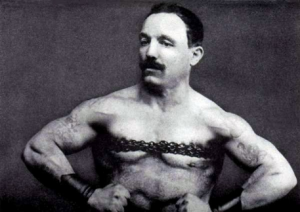
August 17th, 2011 § § permalink
HG never fancied that New York street treat, the “dirty water” hot dog. HG found the fat, soft, salty pretzels that were sold on many Manhattan streets to be a glob of soggy vileness. Even worse was the sad excuse for a Knish that was hawked alongside the dogs and pretzels.
HG did fancy hot chestnuts (especially on a cold Fifth Avenue winter day). But then again, HG just loves chestnuts in many different forms.
For a real New York only inexpensive treat, HG turned to the indoor pleasures of Chinese-Cuban restaurants. After Battista had fallen many Havana based Chinese restaurant owners made their way to NYC because of the large Chinese population. These newly arrived entrepreneurs found a great niche by blending Chinese favorites with the Cuban dishes of their abandoned city. These restaurants flourished (hope they still do) in Washington Heights and on Broadway north of 145th Street. There were a number on the upper West Side as well. Have these been pushed out by chains and upscale retailers?? (Nope, says SJ. La Caridad on 78th and Broadway still dishes out some fine Cuban-Chinese) The dishes HG liked were Moors and Christians (white rice and black beans) and Cubanos (roast pork, ham, pickle and cheese sandwiches pressed into savory yumminess on a grill). Good company for these dishes was an avocado-sweet onion-orange salad followed by a bracing Cuban coffee.
HG knows that the Vietnamese sandwich has burst into the forefront of cheap NYC food favorites, but for HG the classic Cubano remains tops.
August 13th, 2011 § § permalink
“Little Farvel” (AKA Phillip Kovelick) was a Jewish gangster and Murder Inc. member from the Brooklyn neighborhood of Williamsburg . This was long before the area became a favored site of hipsters and cool eateries. This bad guy had the distinction of being named for one of HG’s favorite foods — egg barley called “farvel” in Yiddish.
“Little Farvel” ended his career enclosed, very dead, in a steel drum in Florida. One of Little Farvel’s rivals, in crime and romance, was another Jewish hood, Benjamin “Chippy” Weiner. Chippy was once employed by the HG family firm (sweater manufacturing) where he much admired HG’s father. HG’s father did nor reciprocate the affection. HG liked Chippy and was admonished by his father who pointed to Chippy as a “shandeh” (a shame or disgrace). As predicted by HG’s dad, The Chipster came to a bad end. He did not pay a loan shark named “Farby”, another unsavory Jewish gent, a borrowed 500 bucks. Farby didn’t treat this as a trivial matter. Instead, he employed a very bad Mafia soldier named Santo Bretagna to chastise Chippy. Santo chastised him to death and clumsy Farby and Bretagna got the Sing Sing electric chair for their murderous misdeed.
Another bad guy with a great food nickname was a distant relative of HG’s late cousin, Gladys F. He was dubbed “Potatoes” and was affiliated with Chicago’s Capone mob. But, in HG’s opinion the winner of the Jewish bad guy nickname contest was the late Moses “Moey Dimples” Wolinsky. Runner up: The late Allie “Tick Tock” Tannenbaum.
Wait! What about that egg barley we were discussing? Enough gangster digression, let’s get back to food. Here’s the way HG likes his “farvel”: Toast a cup of egg barley (Manischewitz is a good brand) in some vegetable oil. Add a cup (or more) of hot chicken stock until it is absorbed and the egg barley is tender. Serve it topped with onions and mushrooms sauteed in butter. And, of course, a dollop of sour cream. Or, eliminate the sour cream and serve it as a side with beef stew — it has the same effect as spetzle or buttered egg noodles.
Nosh on that, then raise your wine glass in a joyous toast to those colorfully named bad guys of yesteryear.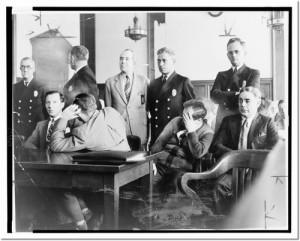
July 30th, 2011 § § permalink
At one point in the distant past, HG collaborated with the distinguished advertising copy writer Charles Ewell on a television project. (Ewell had many distinctions. He headed Volkswagen’s advertising creative team in Germany and played on a Columbia University football team with Jack Kerouac). HG and Charlie would take a break from their lofty endeavors and visit a Chinese restaurant on Seventh Avenue just west of 57th Street. And what did these discerning gentlemen order? Did they dive deep into the mysteries and subtle refinement of authentic Cantonese cuisine? Nope. Combo platters. That’s right. They ordered large platters containing a greasy egg roll, corn starchy shrimp Chop Suey and dark brown pork fried rice. Much hot mustard was applied. Final disgraceful touch: Dabs of very sweet plum sauce on the egg roll and fried rice.
HG blushes with shame at the memory. But, it sure tasted good.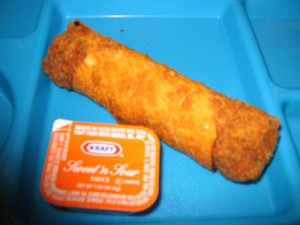
July 3rd, 2011 § § permalink
 Thoughts of ice cold borscht and steamy New York weather make HG recall those refuges from the heat: Dairy restaurants. Dairy restaurants obeyed Jewish dietary laws and served only “dairy” and “pavre” food.
Thoughts of ice cold borscht and steamy New York weather make HG recall those refuges from the heat: Dairy restaurants. Dairy restaurants obeyed Jewish dietary laws and served only “dairy” and “pavre” food.
They served borscht (beet soup), schav (sorrel soup), blintzes (rolled crepes stuffed with cheese or potato) , kasha varnishkes (buckwheat groats with butterfly shaped pasta), potato pirogen (boiled potato and onion dumplings) and more. Big bowls of excellent bread, bialys, onion rolls — also called “pletzels” and copious amounts of butter. Big bowls of thick sour cream were there on the table to accompany every dish. There was fish (considered “parve” a.k.a. neutral meaning neither meat nor dairy) including many varieties of herring; tuna and sardine salads; gefilte fish with strong horse radish.
No meat. Emphatically no meat. Forbidden. A kosher enterprise could not serve both meat and dairy products.
Every Manhattan neighborhood had a Dairy restaurant (okay, not the Upper East Side). The Paradise and Steinberg’s were popular on the West Side. Ratner’s and Rappaport’s ruled the Lower East Side. Scores more in The Bronx and Brooklyn. All gone. Assimilation or changing tastes?
SJ reports only one traditional “Dairy” remains: B&H on Second Avenue. Long may it cool fevered brows and clog arteries.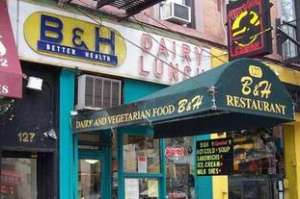
June 29th, 2011 § § permalink
Christ Cella was a New York steak house on East 44th that was a lure for athletes and big eaters. At lunch one day, HG spotted the late Howard Cosell, boxing promoter Don King (of the electric hair) and that deadly jump shooter, Jerry West. HG stopped at West’s table and told him he was forgiven for all the bad things he did to the Knicks. Jerry was amused.
HG always had the same two meals at Christ Cella. In the fall and winter (HG did not dine there in summer, preferring lighter victuals): A scotch sour (freshly squeezed lemon juice); lobster cocktail with Remoulade sauce; New York strip steak (Christ Cella had the all time beefiest, best and biggest steaks in the civilized world) accompanied by salad with Roquefort dressing. Beverage was black and tan (Ballantine India Pale Ale mixed with Guiness Stout—half and half).
In spring HG replaced the steak with a platter of grilled shad, shad roe, bacon, home fried potatoes, sharp tartar sauce and cole slaw. HG never had dessert. Heartier souls knocked off giant portions of New York cheesecake. The admen in the restaurant preceded their meal with two or three martinis.
Yes, indeed, happy drunken high cholesterol days. Those martini drinking, cigarette puffing guys are, of course, a memory like Christ Cella itself.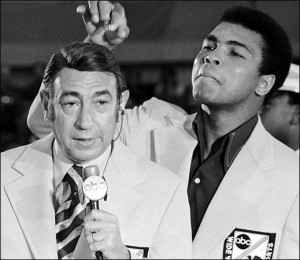
June 27th, 2011 § § permalink
While New York is still chock full of great seafood restaurant there are four (now shuttered) that HG still pines for.
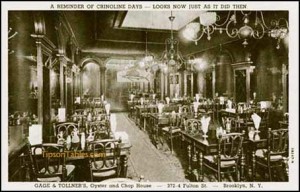 1. Gage and Tollner in downtown Brooklyn. One of the oldest restaurants in New York City, this was a hangout for aristocratic old families of Brooklyn Heights. Entirely illuminated by gas lighting, the untouched turn of the century decor was just wonderful. Dignified, African-American waiters. The sleeves of their jackets had stripes denoting years of service. Average was 25 years. Best dishes: Sauteed clam bellies. Shad and shad roe (in season). Clams and oysters on the half shell. There was also a meat dish fancied by HG: A big, rare (Juicy and gamy) mutton chop accompanied by corn fritters.
1. Gage and Tollner in downtown Brooklyn. One of the oldest restaurants in New York City, this was a hangout for aristocratic old families of Brooklyn Heights. Entirely illuminated by gas lighting, the untouched turn of the century decor was just wonderful. Dignified, African-American waiters. The sleeves of their jackets had stripes denoting years of service. Average was 25 years. Best dishes: Sauteed clam bellies. Shad and shad roe (in season). Clams and oysters on the half shell. There was also a meat dish fancied by HG: A big, rare (Juicy and gamy) mutton chop accompanied by corn fritters.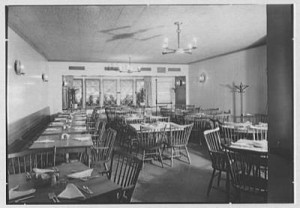
2. Gloucester House in the East 50’s. Chaste New England decor. Very expensive. Clientele: Rich Park Avenue types and publishing biggies. HG often saw Helen Gurley Brown (One time Editor of Cosmopolitan Magazine, author of Sex and the Single Girl and longtime advocate of sexual liberation) and her film producer husband David Brown (“Jaws”, “The Sting.” etc.). Best Dishes: Broiled lobster. Lobster Newburg. Potatoes au gratin. Fried onion rings. Swordfish.
3. Seafood of the Aegean in the East 50’s. Decor: Stylish, yet Greek (hard to imagine, well…just try!). Clientele: Madison Avenue advertising executives. Best dishes: a lemony Avoglemono soup. Shrimp Santorini — Jumbo shrimp with grilled whole tomatoes, tomato sauce and sharp feta cheese — served bubbling hot.
4. Sweets located on the East River waterfront near Wall Street. Decor: Very austere, no frills. Crusty, bad tempered old waiters. Clientele: Wall Streeters and the coffee, tea and cocoa importers that were HQ’d on Water Street. Best dishes: The very best and freshest simply broiled and sauteed fish; clams, oysters, lobsters and crabs—all purchased that morning from the nearby Fulton Street Fish Market.
Anchors Aweigh, Indeed.
June 25th, 2011 § § permalink
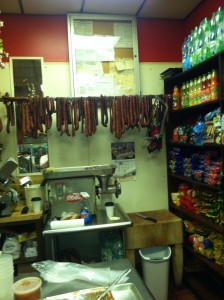
Dried and delicious - good for eating on the way home!
sits smack dab on the blocks (dubbed “South Slope” by real estate agents) where the cachet of Park Slope gently blends into the Mexican/Chinese mosh up of Sunset Park. It is a tiny temple for the worship of smoked and prepared pork products of all kinds. In other words, it is a classic Polish deli simply jammed with house made and house smoked sausages, bacons, and force-meats. There is a line of hard, grizzled thin sausages that range from lightly smoked (pinkesque) to triple smoked (dark and snapping with flavor) and are basically the best Slim Jims you could ever eat. There are Kielbasa in a range of sizes and flavors (spicy, garlicky, fresh, double smoked and one thick and short like a tough, Slavic Bologna). There is a ridiculously juicy Black Forest Ham; the greatest bacon; smoked pork loins; head cheese, liverwurst; a rolled, stuffed veal thing with parsley that almost killed me with pleasure when I paired it with boiled, new potatos. The butchers are all Polish and don’t speak much English and actually aren’t that interested in explaining what everything is….Which is better! That way you can just lose yourself and basically order a little bit of everything. They make all of this in house, so everything is fresh and nitrate free — they also make stews, soups, vats of pickles and sauerkraut and once I came in and there were about 15 different smoked fishes on newspapers that were amongst the best I have ever had. And — here’s the kicker — its cheap. I mean REALLY cheap!!! I have bought BAGS of stuff there and never gone over seventy bucks. It is an inspiration. These guys are artisans, old school butchers, examples of real, local food-ways and they don’t feel the need to have tattoos of pigs on their necks, and weird 1910 mustaches, and charge $20 a pound for “house-cured” bacon like this whole new realm of
hipster butcher/food producers. Why? Because the Jubilat guys are part of their community, they are FEEDING their community with reasonably priced GREAT, homemade food.
I digress. The politics of food and community are interesting but not as interesting as a quick tip if you ever make it over to Jubilat. Basically buy a spread of smoked meats and make sure to include the bacon, a kielbasa (or many types of kielbasa), some frankfurter and whatever else catches your eye. Buy a bunch of sauerkraut, a jar of super strong Polish mustard and truck back to your house with a dry Riesling and bunch of friends. Cook the sauerkraut with onion, a cup or two of that Riesling (add some juniper berries if you can!) and some new potatoes. Layer the smoked meats on top and basically by the time the potatos are cooked through you have one of the great meals of all time. Crack open some dark beers, cheer the noble men of Jubilat, and get to work…thank HG and SJ later.
Jubilat Provisions – 608 5th Ave – Brooklyn, NYC

June 25th, 2011 § § permalink
Rockaway was the proletarian barrier beach (between the Atlantic Ocean and Jamaica Bay) where HG and millions of sweltering New Yorkers escaped the summer blaze in years gone by. During the 70s, 80s and 90s, drug violence and the proximity to some fairly dangerous public housing lessened its attractiveness. But, Rockaway has re-surfaced with a sudden cache of cool. It started with a movement of urban surfers, who did not care that Rockaway’s waves were not California size, they were NYC waves and that was cool enough. They carried their surf boards on the subway and soon Williamsburg hipsters and lots of other cool folks from Brooklyn and Manhattan wanted to see what was going on. (Rockaway is reached by a comparatively short subway ride).
And, where there are hipsters, there’s hip food and drink. The New York Times has been reporting on the opening of many good, casual ethnic dining spots along the Rockaway Boardwalk.
HG suggests it may be time to revive that great beach classic –The Takee Cup. HG wistfully recalled the tasty Takee Cup in a post a few months ago. Bring it back for the new cool generation.